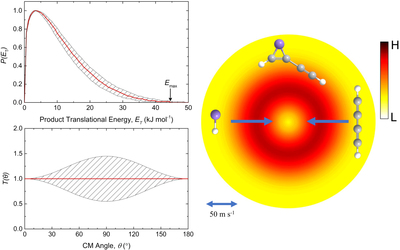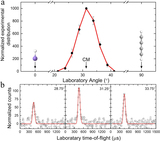Image Details

On the Synthesis of the Astronomically Elusive 1-Ethynyl-3-Silacyclopropenylidene (c-SiC4H2) Molecule in Circumstellar Envelopes of Carbon-rich Asymptotic Giant Branch Stars and Its Potential Role in the Formation of the Silicon Tetracarbide Chain (SiC4)
2021 The Astrophysical Journal Letters 908 L40.
- Provider: AAS Journals
Caption: Figure 4.
Translational energy flux distributions (top-left panel) and center-of-mass angular (bottom-left panel) and the top view of the flux contour map (right) leading to the synthesis of the 1-ethynyl-3-silacyclopropenylidene molecule (c-SiC4H2) plus atomic hydrogen in the reaction of the silylidyne radical with diacetylene. Hatched areas indicate the acceptable upper and lower error limits of the fits. The solid red lines define the best-fit function to replicate the laboratory data as shown in Figure 3. The flux contour map represents the flux intensity of the reactive scattering products as a function of the CM scattering angle (θ) and product velocity (u). The color bar indicates the flux gradient from high (H) intensity to low (L) intensity.
Copyright and Terms & Conditions
© 2021. The American Astronomical Society. All rights reserved.







